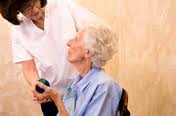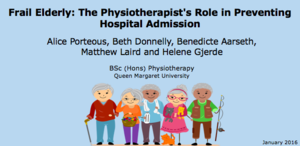Comprehensive Geriatric Assessment: Difference between revisions
Scott Buxton (talk | contribs) m (Beginning to edit for my latest course on PP+) |
Scott Buxton (talk | contribs) m (Continuing to update for the PP+ Course) |
||
| Line 1: | Line 1: | ||
<div class="editorbox"> '''Original Editor '''- [[User:Lucinda hampton|Lucinda hampton]] '''Top Contributors''' - {{Special:Contributors/{{FULLPAGENAME}}}}</div> | <div class="editorbox"> '''Original Editor '''- [[User:Lucinda hampton|Lucinda hampton]] '''Top Contributors''' - {{Special:Contributors/{{FULLPAGENAME}}}}</div> | ||
== Purpose == | == Purpose == | ||
[[File:Elderly Physio.jpg|right|frameless]]<br>'''Comprehensive geriatric assessment''' (CGA) is | [[File:Elderly Physio.jpg|right|frameless]]<br>'''Comprehensive geriatric assessment''' (CGA) is an iterative collaborative framework and process of assessment used to assess people living with frailty. These people often have complex, multiple and interdependent problems (multimorbidity) which make their care more challenging than in younger people, or those with just one medical problem.<ref name=":0">Wikipedia. [https://en.wikipedia.org/wiki/Comprehensive_geriatric_assessment Comprehensive Geriatric Assessment.] Available from: https://en.wikipedia.org/wiki/Comprehensive_geriatric_assessment (last accessed 4.5.2019)</ref>. The strength of the CGA lies in the fact it is a multidimensional holistic assessment of an older person that takes into consideration health and wellbeing. A plan is then formulated to address issues which are of concern to the older person (and family/carers if relevant) and arranges interventions according to the plan and then reviews the impact. | ||
The CGA differs from a standard evaluation as it emphasizes quality of life and functional status, prognosis, and outcome, entailing greater depth and breadth. The hallmarks of CGA are the employment of interdisciplinary teams and the use of any number of standardized instruments to evaluate aspects of patient functioning, impairments, and social supports.<ref>CGA toolkit. [https://www.cgakit.com/cga Comprehensive geriatric assessment.] Available from: https://www.cgakit.com/cga (last accessed 4.5.2019)</ref>{{#ev:youtube|https://www.youtube.com/watch?v=ni2FaEboCZU&app=desktop|width}}<ref>thehealthline.ca Information Network. Introduction to the Comprehensive Geriatric Assessment Toolkit. AVailable from: https://www.youtube.com/watch?v=ni2FaEboCZU&app=desktop (last accessed 4.5.2019) | |||
The CGA differs from a standard evaluation as it emphasizes quality of life and functional status, prognosis, and outcome, entailing greater depth and breadth. | |||
The hallmarks of CGA are the employment of interdisciplinary teams and the use of any number of standardized instruments to evaluate aspects of patient functioning, impairments, and social supports.<ref>CGA toolkit. [https://www.cgakit.com/cga Comprehensive geriatric assessment.] Available from: https://www.cgakit.com/cga (last accessed 4.5.2019)</ref> | |||
{{#ev:youtube|https://www.youtube.com/watch?v=ni2FaEboCZU&app=desktop|width}}<ref>thehealthline.ca Information Network. Introduction to the Comprehensive Geriatric Assessment Toolkit. AVailable from: https://www.youtube.com/watch?v=ni2FaEboCZU&app=desktop (last accessed 4.5.2019) | |||
</ref> | </ref> | ||
== | == The Centre of The CGA == | ||
There are five domains at the centre of the CGA which form the framework for the assessment. By ensuring each domain is considered during each assessment the patient and their needs are considered as a whole. The benefits gained by performing the CGA are only realised when all of the domains are covered. | |||
# [[Physical Activity Scale for the Elderly (PASE)|Physical health]] (e.g. COAD, osteoarthritis) | # [[Physical Activity Scale for the Elderly (PASE)|Physical health]] (e.g. COAD, osteoarthritis) | ||
# [[Mental Health, Physical Activity and Physical Therapy|Mental health]] (e.g. depression, vascular dementia) | # [[Mental Health, Physical Activity and Physical Therapy|Mental health]] (e.g. depression, vascular dementia) | ||
| Line 20: | Line 15: | ||
From the assessment, using validated and reliable [[Outcome Measures|outcome measures]], a list of problems is formulated and recorded. This allows problems identified to then be addressed. This problem solving draws on the expertise of the [[Multidisciplinary/interdisciplinary management of the amputee|multidisciplinary]] (MDT) team. | From the assessment, using validated and reliable [[Outcome Measures|outcome measures]], a list of problems is formulated and recorded. This allows problems identified to then be addressed. This problem solving draws on the expertise of the [[Multidisciplinary/interdisciplinary management of the amputee|multidisciplinary]] (MDT) team. | ||
Each expert in multidisciplinary team (MDT) assess their domain. The physician (usually a geriatrician or GP) assesses physical and mental health; the pharmacist may undertake a medication review; the nurse assesses various aspects of personal care (for example hygiene and continence); the physiotherapist, balance and mobility; the occupational therapist, activities of daily living; and the social worker, social aspects of the case. If needed others may be involved in the MDT assessment eg speech therapist, dietician<ref name=":0" /> | Each expert in multidisciplinary team (MDT) assess their domain. The physician (usually a geriatrician or GP) assesses physical and mental health; the pharmacist may undertake a medication review; the nurse assesses various aspects of personal care (for example hygiene and continence); the physiotherapist, balance and mobility; the occupational therapist, activities of daily living; and the social worker, social aspects of the case. If needed others may be involved in the MDT assessment eg speech therapist, dietician<ref name=":0" />. | ||
This is not to say that different professions can assess different domains, it is about considering who is best places and best equipped to do the best thing for the patient at that time. | |||
== Physiotherapists' Role in the CGA == | == Physiotherapists' Role in the CGA == | ||
[[File:Frail elderly Banner.png|right|frameless]]The Physiotherapists involvement in the delivery of a CGA can be incredibly varied and ultimately depends on your speciality, which setting you work in and the reasons for the patient being referred to you. | [[File:Frail elderly Banner.png|right|frameless]]The Physiotherapists involvement in the delivery of a CGA can be incredibly varied and ultimately depends on your speciality, which setting you work in and the reasons for the patient being referred to you. | ||
Revision as of 10:12, 30 July 2020
Purpose[edit | edit source]
Comprehensive geriatric assessment (CGA) is an iterative collaborative framework and process of assessment used to assess people living with frailty. These people often have complex, multiple and interdependent problems (multimorbidity) which make their care more challenging than in younger people, or those with just one medical problem.[1]. The strength of the CGA lies in the fact it is a multidimensional holistic assessment of an older person that takes into consideration health and wellbeing. A plan is then formulated to address issues which are of concern to the older person (and family/carers if relevant) and arranges interventions according to the plan and then reviews the impact.
The CGA differs from a standard evaluation as it emphasizes quality of life and functional status, prognosis, and outcome, entailing greater depth and breadth. The hallmarks of CGA are the employment of interdisciplinary teams and the use of any number of standardized instruments to evaluate aspects of patient functioning, impairments, and social supports.[2]
The Centre of The CGA[edit | edit source]
There are five domains at the centre of the CGA which form the framework for the assessment. By ensuring each domain is considered during each assessment the patient and their needs are considered as a whole. The benefits gained by performing the CGA are only realised when all of the domains are covered.
- Physical health (e.g. COAD, osteoarthritis)
- Mental health (e.g. depression, vascular dementia)
- Functional (e.g. unable to shower herself, or do cleaning)
- Social (e.g. lives alone, family far away)
- Environmental (e.g. stairs to bedroom [fall risk],poor lighting)
From the assessment, using validated and reliable outcome measures, a list of problems is formulated and recorded. This allows problems identified to then be addressed. This problem solving draws on the expertise of the multidisciplinary (MDT) team.
Each expert in multidisciplinary team (MDT) assess their domain. The physician (usually a geriatrician or GP) assesses physical and mental health; the pharmacist may undertake a medication review; the nurse assesses various aspects of personal care (for example hygiene and continence); the physiotherapist, balance and mobility; the occupational therapist, activities of daily living; and the social worker, social aspects of the case. If needed others may be involved in the MDT assessment eg speech therapist, dietician[1].
This is not to say that different professions can assess different domains, it is about considering who is best places and best equipped to do the best thing for the patient at that time.
Physiotherapists' Role in the CGA[edit | edit source]
The Physiotherapists involvement in the delivery of a CGA can be incredibly varied and ultimately depends on your speciality, which setting you work in and the reasons for the patient being referred to you.
Functional status — Functional status refers to the ability to perform activities necessary or desirable in daily life. Functional status is directly influenced by health conditions, particularly in the context of an elder's environment and social support network.
Activities of daily living —including: basic activities of daily living (BADLs) eg bathing, dressing, instrumental or intermediate activities of daily living (IADLs) eg shopping, telephoning, taking medicine , and advanced activities of daily living (AADLs) eg being able to partake in social activities.
Gait speed — In addition to measures of ADLs, gait speed alone predicts functional decline and early mortality in older adults. Assessing gait speed in clinical practice may identify patients who need further evaluation, such as those at increased risk of falls.
Falls/balance — Approximately one-third of community-dwelling persons age 65 years and one-half of those over 80 years of age fall each year. Patients who have fallen or have a gait or balance problem are at higher risk of having a subsequent fall and losing independence. An assessment of fall risk should be integrated into the history and physical examination of all geriatric patients.[4]
Outcome Measures[edit | edit source]
Examples of outcome measures that could be employed include
- Patient Specific Functional Scale
- Barthel index
- Katz ADL
- FIM
- Elderly Mobility Scale
- BOOMER
- Romberg test
- TUG
- Functional Reach
- 10 metre walk test
Evidence[edit | edit source]
A 2017 Cochrane review found that older people are more likely to be alive and in their own homes at follow-up if they received CGA on admission to hospital. [5]
A 2017 study on physical fitness of the frail elderly is enhanced by use of a CGA.It found that in their acute care a CGA unit showed superior results (cf conventional care) in terms of preserving physical fitness at 3 months follow-up. CGA management may positively influence outcomes of great importance for these patients, such as mobility, strength, and endurance.[6]
References[edit | edit source]
- ↑ 1.0 1.1 Wikipedia. Comprehensive Geriatric Assessment. Available from: https://en.wikipedia.org/wiki/Comprehensive_geriatric_assessment (last accessed 4.5.2019)
- ↑ CGA toolkit. Comprehensive geriatric assessment. Available from: https://www.cgakit.com/cga (last accessed 4.5.2019)
- ↑ thehealthline.ca Information Network. Introduction to the Comprehensive Geriatric Assessment Toolkit. AVailable from: https://www.youtube.com/watch?v=ni2FaEboCZU&app=desktop (last accessed 4.5.2019)
- ↑ UptoDate. Comprehensive geriatric assessment. Available from: https://www.uptodate.com/contents/comprehensive-geriatric-assessment (last accessed 4.5.2019)
- ↑ Ellis G, Gardner M, Tsiachristas A, Langhorne P, Burke O, Harwood RH, Conroy SP, Kircher T, Somme D, Saltvedt I, Wald H. Comprehensive geriatric assessment for older adults admitted to hospital. Cochrane database of systematic reviews. 2017(9). Available from: https://www.cochrane.org/CD006211/EPOC_comprehensive-geriatric-assessment-older-adults-admitted-hospital (last accessed 4.5.2019)
- ↑ Åhlund K, Bäck M, Öberg B, Ekerstad N. Effects of comprehensive geriatric assessment on physical fitness in an acute medical setting for frail elderly patients. Clinical interventions in aging. 2017;12:1929. Available from: https://www.ncbi.nlm.nih.gov/pmc/articles/PMC5691905/ (last accessed 4.5.2019)








